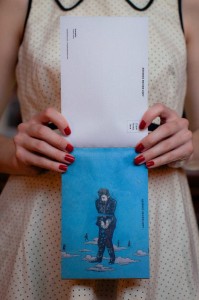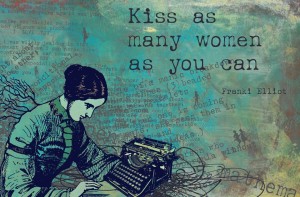Kiss As Many Women As You Can by Franki Elliot and Shawn Stucky
Kiss As Many Women As You Can
By Franki Elliot and Shawn Stucky
Curbside Splendor Publishing, Inc.
Paperback
978-0-9884804-5-2
Franki Elliot‘s short story collection, Kiss As Many Women As You Can, which is illustrated by Shawn Stucky, contains whispered secrets told through postcard format. The stories range from short tales that suggest larger personal experiences to pieces of advice only known from hard learned lessons. Elliot’s poetry-tinged prose lends an intimacy to the collection that makes it seem like they were written in a notebook only for the writer’s eyes.
The collection’s format is part of the overall enjoyment. Each postcard can be torn out and mailed, suggesting that the collection should be shared. The stories’ unassuming titles are located on the bottom left address side of the postcard in small black lettering, non-descript and easy to miss. I felt the desire to send one of Stucky’s pieces or Elliot’s stories to loved ones many times while reading. At its best I felt as if Elliot and Stucky were entrusting me not only with the secrets but what exactly to do with them. Do I keep them to myself or should I share them?
 This is most effectively seen in the stories told in first person. Elliot’s first story, “i love you” feels like something meant for the speaker’s eyes only: “I remember you tackled me into the snow and shouted, I LOVE YOU. And I was wildly jealous in that moment because I can never lose control and I can never say I LOVE YOU (especially) when it is true.” It’s secretive and utterly relatable. There are some in the collection that are a bit inane, like “orange soda,” a story about a French millionaire who says his last lover was “like drinking orange juice from a can.” “friends who become family” is one of the advice stories, telling the reader that should they have friends that have become family “it is best to hold on as tight as you can.” As the collection goes along Elliot’s strong writing displays itself with stories that are longer and poignant. The last story, “finding something” delves into the area of having lost everything: “but i say you only find something when you hit rock bottom, when you lose everything you thought meant something and have to start over. that is when you find the greatest thing of all…yourself.” It’s another personal additive that most everyone can understand on some level.
This is most effectively seen in the stories told in first person. Elliot’s first story, “i love you” feels like something meant for the speaker’s eyes only: “I remember you tackled me into the snow and shouted, I LOVE YOU. And I was wildly jealous in that moment because I can never lose control and I can never say I LOVE YOU (especially) when it is true.” It’s secretive and utterly relatable. There are some in the collection that are a bit inane, like “orange soda,” a story about a French millionaire who says his last lover was “like drinking orange juice from a can.” “friends who become family” is one of the advice stories, telling the reader that should they have friends that have become family “it is best to hold on as tight as you can.” As the collection goes along Elliot’s strong writing displays itself with stories that are longer and poignant. The last story, “finding something” delves into the area of having lost everything: “but i say you only find something when you hit rock bottom, when you lose everything you thought meant something and have to start over. that is when you find the greatest thing of all…yourself.” It’s another personal additive that most everyone can understand on some level.
Stucky’s accompanying artwork doesn’t support Elliot’s words as much as they tell their own stories. The red-green blind artist uses mostly bold, single color backgrounds to initially catch the eye. Two of the stronger pieces, “may this be love” and “sleepwalkers” are like this. Both have a bold, but not bright background color with a drawing of people on top, all in black. Stucky’s work makes you want to learn about his process and the story behind each piece. How does a periwinkle background with two young kids, an older girl and younger boy, holding hands in a modified field become “sleepwalkers?” Some of the postcards have a multicolor background, as in “not all friends are horses” where blue is the dominant color, but red, yellow, and the various hues within their spectrums are used. (Blue acts as a dominant color within the collection.) A few of the postcards such as “love” use the same typewriter font in the background, an artistic nod to Elliot’s original composition method.
The collection is titled after two pieces both called “kiss as many women as you can.” Elliot’s version tells the story of Victorio and the advice a prostitute gave him when he was 14-years-old that he now considers the best and worst advice he ever got: “honey, kiss as many women as you can but NEVER fall in love.” Stucky’s version highlights a woman in Victorian era clothing using a typewriter, the blue background disrupted by the lines from Elliot’s stories mostly congregating on the bottom left side of the postcard. Three figures from Stucky’s others pieces appear in the background, such as a smaller version of the little girl in “sleepwalkers.” Stucky uses the background as the one connection between the two artists and their works in a compelling narrative of lust and love. Whether each secret is kept or shared is up to each individual reader.
